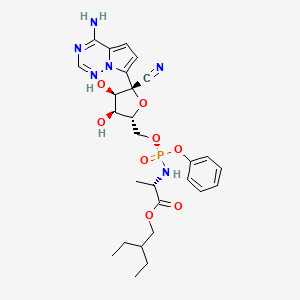
3QKI37EEHE
Descripción general
Descripción
Inicialmente fue desarrollado por Gilead Sciences para el tratamiento de la enfermedad por virus del Ébola y desde entonces ha ganado considerable atención por su posible uso contra otras infecciones virales, incluido el síndrome respiratorio agudo severo coronavirus 2 (SARS-CoV-2), el virus responsable de COVID-19 .
Aplicaciones Científicas De Investigación
GS-5734 tiene una amplia gama de aplicaciones de investigación científica, que incluyen:
Química: Utilizado como un compuesto modelo para estudiar análogos de nucleósidos y sus reacciones.
Biología: Investigado por su actividad antiviral contra una variedad de virus de ARN.
Medicina: Aprobado para el tratamiento de COVID-19 y estudiado por su posible uso contra otras infecciones virales como el Ébola, el síndrome respiratorio de Oriente Medio (MERS) y el síndrome respiratorio agudo severo (SARS)
Industria: Utilizado en el desarrollo de terapias antivirales y como un compuesto de referencia en la investigación farmacéutica
Mecanismo De Acción
GS-5734 ejerce sus efectos antivirales al inhibir la enzima ARN polimerasa dependiente de ARN (RdRp), que es esencial para la replicación viral. Una vez dentro de la célula huésped, GS-5734 se metaboliza a su forma trifosfato activa, que compite con los nucleótidos naturales para su incorporación al ARN viral. Esta incorporación conduce a la terminación prematura de la síntesis de ARN, inhibiendo eficazmente la replicación viral .
Análisis Bioquímico
Biochemical Properties
Remdesivir interacts with the viral RNA-dependent RNA polymerase, an enzyme crucial for viral replication . It is metabolized by the host cell into its active form, a triphosphate (TP) metabolite . This metabolite inhibits viral replication by acting as a chain terminator during the synthesis of viral RNA .
Cellular Effects
Remdesivir has been shown to inhibit the replication of various coronaviruses in human airway epithelial cells . It reduces viral load and improves clinical signs of disease as well as respiratory function .
Molecular Mechanism
The active triphosphate metabolite of Remdesivir incorporates into the growing RNA chain during viral replication. This causes premature termination of the RNA synthesis, thereby inhibiting the replication of the virus . It’s worth noting that Remdesivir can exert its effects even in the presence of the viral proofreading exoribonuclease, an enzyme that often complicates the development of antiviral nucleosides .
Temporal Effects in Laboratory Settings
In laboratory settings, Remdesivir has shown to reduce viral RNA levels in a dose-dependent manner that parallels impairment of viral titer . While it is highly active against wild-type viruses, it has been found to be even more active against viruses lacking the proofreading activity of the exoribonuclease .
Dosage Effects in Animal Models
In animal models, both prophylactic and early therapeutic administration of Remdesivir have significantly reduced lung viral load and improved clinical signs of disease . A study on male mice suggested that a high dosage of Remdesivir may induce testicular toxicity and result in deterioration of sperm parameters .
Metabolic Pathways
Remdesivir is a prodrug that requires metabolism by the host cell to form the pharmacologically active triphosphate metabolite
Transport and Distribution
As a prodrug, it is designed to deliver the nucleoside monophosphate into the cell, thereby circumventing the rate-limiting first phosphorylation step and allowing for efficient intracellular delivery .
Métodos De Preparación
Rutas Sintéticas y Condiciones de Reacción
La síntesis de GS-5734 involucra múltiples pasos, comenzando con materiales de partida disponibles comercialmente. Los pasos clave incluyen la formación del análogo de nucleósido y su posterior fosforilación para producir la forma trifosfato activa. La ruta sintética generalmente implica pasos de protección y desprotección, reacciones de sustitución nucleofílica y reacciones de fosforilación bajo condiciones controladas .
Métodos de Producción Industrial
La producción industrial de GS-5734 sigue una ruta sintética similar, pero está optimizada para la fabricación a gran escala. Esto implica el uso de reacciones de alto rendimiento, métodos de purificación eficientes y medidas estrictas de control de calidad para garantizar la consistencia y la pureza del producto final .
Análisis De Reacciones Químicas
Tipos de Reacciones
GS-5734 experimenta varios tipos de reacciones químicas, que incluyen:
Oxidación: GS-5734 puede oxidarse para formar varios metabolitos.
Reducción: Las reacciones de reducción pueden modificar la estructura del análogo de nucleósido.
Sustitución: Las reacciones de sustitución nucleofílica están involucradas en la síntesis de GS-5734
Reactivos y Condiciones Comunes
Los reactivos comunes utilizados en la síntesis y reacciones de GS-5734 incluyen:
Agentes fosforilantes: Utilizados para los pasos de fosforilación.
Grupos protectores: Utilizados para proteger los grupos funcionales durante la síntesis.
Solventes: Como el dimetilsulfóxido (DMSO) y el acetonitrilo, utilizados como medios de reacción.
Principales Productos Formados
Los principales productos formados a partir de las reacciones de GS-5734 incluyen su forma trifosfato activa, el remdesivir trifosfato y varios metabolitos formados a través de reacciones de oxidación y reducción .
Comparación Con Compuestos Similares
Compuestos Similares
GS-441524: Un análogo de nucleósido padre de GS-5734 con actividad antiviral similar.
Favipiravir: Otro análogo de nucleósido con actividad antiviral de amplio espectro.
Ribavirina: Un análogo de nucleósido utilizado para tratar varias infecciones virales.
Unicidad de GS-5734
GS-5734 es único debido a su actividad antiviral de amplio espectro y su capacidad para inhibir una amplia gama de virus de ARN, incluidos los coronavirus y los filovirus. Su eficacia contra el SARS-CoV-2 lo ha convertido en un componente crítico en la lucha contra COVID-19 .
Propiedades
IUPAC Name |
2-ethylbutyl (2S)-2-[[[(2R,3S,4R,5R)-5-(4-aminopyrrolo[2,1-f][1,2,4]triazin-7-yl)-5-cyano-3,4-dihydroxyoxolan-2-yl]methoxy-phenoxyphosphoryl]amino]propanoate | |
|---|---|---|
| Source | PubChem | |
| URL | https://pubchem.ncbi.nlm.nih.gov | |
| Description | Data deposited in or computed by PubChem | |
InChI |
InChI=1S/C27H35N6O8P/c1-4-18(5-2)13-38-26(36)17(3)32-42(37,41-19-9-7-6-8-10-19)39-14-21-23(34)24(35)27(15-28,40-21)22-12-11-20-25(29)30-16-31-33(20)22/h6-12,16-18,21,23-24,34-35H,4-5,13-14H2,1-3H3,(H,32,37)(H2,29,30,31)/t17-,21+,23+,24+,27-,42-/m0/s1 | |
| Source | PubChem | |
| URL | https://pubchem.ncbi.nlm.nih.gov | |
| Description | Data deposited in or computed by PubChem | |
InChI Key |
RWWYLEGWBNMMLJ-YSOARWBDSA-N | |
| Source | PubChem | |
| URL | https://pubchem.ncbi.nlm.nih.gov | |
| Description | Data deposited in or computed by PubChem | |
Canonical SMILES |
CCC(CC)COC(=O)C(C)NP(=O)(OCC1C(C(C(O1)(C#N)C2=CC=C3N2N=CN=C3N)O)O)OC4=CC=CC=C4 | |
| Source | PubChem | |
| URL | https://pubchem.ncbi.nlm.nih.gov | |
| Description | Data deposited in or computed by PubChem | |
Isomeric SMILES |
CCC(CC)COC(=O)[C@H](C)N[P@](=O)(OC[C@@H]1[C@H]([C@H]([C@](O1)(C#N)C2=CC=C3N2N=CN=C3N)O)O)OC4=CC=CC=C4 | |
| Source | PubChem | |
| URL | https://pubchem.ncbi.nlm.nih.gov | |
| Description | Data deposited in or computed by PubChem | |
Molecular Formula |
C27H35N6O8P | |
| Source | PubChem | |
| URL | https://pubchem.ncbi.nlm.nih.gov | |
| Description | Data deposited in or computed by PubChem | |
DSSTOX Substance ID |
DTXSID701022537 | |
| Record name | Remdesivir | |
| Source | EPA DSSTox | |
| URL | https://comptox.epa.gov/dashboard/DTXSID701022537 | |
| Description | DSSTox provides a high quality public chemistry resource for supporting improved predictive toxicology. | |
Molecular Weight |
602.6 g/mol | |
| Source | PubChem | |
| URL | https://pubchem.ncbi.nlm.nih.gov | |
| Description | Data deposited in or computed by PubChem | |
Mechanism of Action |
COVID-19 is caused by the positive-sense RNA virus severe acute respiratory syndrome coronavirus 2 (SARS-CoV-2). Replication of the viral genome is a key step in the infectious cycle of RNA viruses, including those of the _Filoviridae_, _Paramyxoviridae_, _Pneumoviridae_, and _Coronaviridae_ families, and is carried out by viral RNA-dependent RNA polymerase (RdRp) enzymes or enzyme complexes. For both SARS-CoV and SARS-CoV-2, the RdRp comprises nsp7, nsp8, and nsp12 subunits under physiological conditions, although functional RdRp complexes can be reassembled _in vitro_ that incorporate only the nsp8 and nsp12 subunits, similar to the Middle East respiratory syndrome coronavirus (MERS-CoV). Remdesivir is a phosphoramidite prodrug of a 1'-cyano-substituted adenosine nucleotide analogue that competes with ATP for incorporation into newly synthesized viral RNA by the corresponding RdRp complex. Remdesivir enters cells before being cleaved to its monophosphate form through the action of either carboxylesterase 1 or cathepsin A; it is subsequently phosphorylated by undescribed kinases to yield its active triphosphate form remdesivir triphosphate (RDV-TP or GS-443902). RDV-TP is efficiently incorporated by the SARS-CoV-2 RdRp complex, with a 3.65-fold selectivity for RDV-TP over endogenous ATP. Unlike some nucleoside analogues, remdesivir provides a free 3'-hydroxyl group that allows for continued chain elongation. However, modelling and _in vitro_ experiments suggest that at _i_ + 4 (corresponding to the position for the incorporation of the fourth nucleotide following RDV-TP incorporation), the 1'-cyano group of remdesivir sterically clashes with Ser-861 of the RdRp, preventing further enzyme translocation and terminating replication at position _i_ + 3. This mechanism was essentially identical between SARS-CoV, SARS-CoV-2, and MERS-CoV, and genomic comparisons reveal that Ser-861 is conserved across alpha-, beta-, and deltacoronaviruses, suggesting remdesivir may possess broad antiviral activity. Considerations for the use of nucleotide analogues like remdesivir include the possible accumulation of resistance mutations. Excision of analogues through the 3'-5' exonuclease (ExoN) activity of replication complexes, mediated in SARS-CoV by the nsp14 subunit, is of possible concern. Murine hepatitis viruses (MHVs) engineered to lack ExoN activity are approximately 4-fold more susceptible to remdesivir, supporting the proposed mechanism of action. However, the relatively mild benefit of ExoN activity to remdesivir resistance is proposed to involve its delayed chain termination mechanism, whereby additional endogenous nucleotides are incorporated following RDV-TP. In addition, serial passage of MHV in increasing concentrations of the remdesivir parent molecule [GS-441524] led to the development of resistance mutations F476L and V553L, which maintain activity when transferred to SARS-CoV. However, these mutant viruses are less fit than wild-type in both competition assays and _in vivo_ in the absence of selective pressure. To date, no clinical data on SARS-CoV-2 resistance to remdesivir have been described. | |
| Record name | Remdesivir | |
| Source | DrugBank | |
| URL | https://www.drugbank.ca/drugs/DB14761 | |
| Description | The DrugBank database is a unique bioinformatics and cheminformatics resource that combines detailed drug (i.e. chemical, pharmacological and pharmaceutical) data with comprehensive drug target (i.e. sequence, structure, and pathway) information. | |
| Explanation | Creative Common's Attribution-NonCommercial 4.0 International License (http://creativecommons.org/licenses/by-nc/4.0/legalcode) | |
CAS No. |
1809249-37-3 | |
| Record name | L-Alanine, N-[(S)-hydroxyphenoxyphosphinyl]-, 2-ethylbutyl ester, 6-ester with 2-C-(4-aminopyrrolo[2,1-f][1,2,4]triazin-7-yl)-2,5-anhydro-D-altrononitrile | |
| Source | CAS Common Chemistry | |
| URL | https://commonchemistry.cas.org/detail?cas_rn=1809249-37-3 | |
| Description | CAS Common Chemistry is an open community resource for accessing chemical information. Nearly 500,000 chemical substances from CAS REGISTRY cover areas of community interest, including common and frequently regulated chemicals, and those relevant to high school and undergraduate chemistry classes. This chemical information, curated by our expert scientists, is provided in alignment with our mission as a division of the American Chemical Society. | |
| Explanation | The data from CAS Common Chemistry is provided under a CC-BY-NC 4.0 license, unless otherwise stated. | |
| Record name | Remdesivir [USAN] | |
| Source | ChemIDplus | |
| URL | https://pubchem.ncbi.nlm.nih.gov/substance/?source=chemidplus&sourceid=1809249373 | |
| Description | ChemIDplus is a free, web search system that provides access to the structure and nomenclature authority files used for the identification of chemical substances cited in National Library of Medicine (NLM) databases, including the TOXNET system. | |
| Record name | Remdesivir | |
| Source | DrugBank | |
| URL | https://www.drugbank.ca/drugs/DB14761 | |
| Description | The DrugBank database is a unique bioinformatics and cheminformatics resource that combines detailed drug (i.e. chemical, pharmacological and pharmaceutical) data with comprehensive drug target (i.e. sequence, structure, and pathway) information. | |
| Explanation | Creative Common's Attribution-NonCommercial 4.0 International License (http://creativecommons.org/licenses/by-nc/4.0/legalcode) | |
| Record name | Remdesivir | |
| Source | EPA DSSTox | |
| URL | https://comptox.epa.gov/dashboard/DTXSID701022537 | |
| Description | DSSTox provides a high quality public chemistry resource for supporting improved predictive toxicology. | |
| Record name | 2-ethylbutyl (2S)-2-[[[(2R,3S,4R,5R)-5-(4-aminopyrrolo[2,1-f][1,2,4]triazin-7-yl)-5-cyano-3,4-dihydroxyoxolan-2-yl]methoxy-phenoxyphosphoryl]amino]propanoate | |
| Source | European Chemicals Agency (ECHA) | |
| URL | https://echa.europa.eu/information-on-chemicals | |
| Description | The European Chemicals Agency (ECHA) is an agency of the European Union which is the driving force among regulatory authorities in implementing the EU's groundbreaking chemicals legislation for the benefit of human health and the environment as well as for innovation and competitiveness. | |
| Explanation | Use of the information, documents and data from the ECHA website is subject to the terms and conditions of this Legal Notice, and subject to other binding limitations provided for under applicable law, the information, documents and data made available on the ECHA website may be reproduced, distributed and/or used, totally or in part, for non-commercial purposes provided that ECHA is acknowledged as the source: "Source: European Chemicals Agency, http://echa.europa.eu/". Such acknowledgement must be included in each copy of the material. ECHA permits and encourages organisations and individuals to create links to the ECHA website under the following cumulative conditions: Links can only be made to webpages that provide a link to the Legal Notice page. | |
| Record name | REMDESIVIR | |
| Source | FDA Global Substance Registration System (GSRS) | |
| URL | https://gsrs.ncats.nih.gov/ginas/app/beta/substances/3QKI37EEHE | |
| Description | The FDA Global Substance Registration System (GSRS) enables the efficient and accurate exchange of information on what substances are in regulated products. Instead of relying on names, which vary across regulatory domains, countries, and regions, the GSRS knowledge base makes it possible for substances to be defined by standardized, scientific descriptions. | |
| Explanation | Unless otherwise noted, the contents of the FDA website (www.fda.gov), both text and graphics, are not copyrighted. They are in the public domain and may be republished, reprinted and otherwise used freely by anyone without the need to obtain permission from FDA. Credit to the U.S. Food and Drug Administration as the source is appreciated but not required. | |
Descargo de responsabilidad e información sobre productos de investigación in vitro
Tenga en cuenta que todos los artículos e información de productos presentados en BenchChem están destinados únicamente con fines informativos. Los productos disponibles para la compra en BenchChem están diseñados específicamente para estudios in vitro, que se realizan fuera de organismos vivos. Los estudios in vitro, derivados del término latino "in vidrio", involucran experimentos realizados en entornos de laboratorio controlados utilizando células o tejidos. Es importante tener en cuenta que estos productos no se clasifican como medicamentos y no han recibido la aprobación de la FDA para la prevención, tratamiento o cura de ninguna condición médica, dolencia o enfermedad. Debemos enfatizar que cualquier forma de introducción corporal de estos productos en humanos o animales está estrictamente prohibida por ley. Es esencial adherirse a estas pautas para garantizar el cumplimiento de los estándares legales y éticos en la investigación y experimentación.



![4-{4-[(2,5-dibromophenyl)sulfonyl]-1-piperazinyl}phenyl methyl ether](/img/structure/B604836.png)
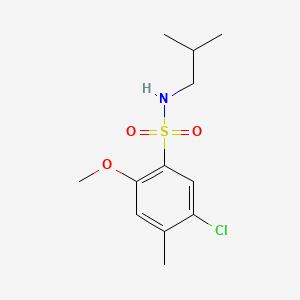
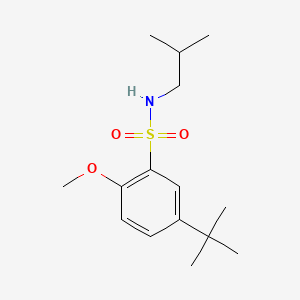
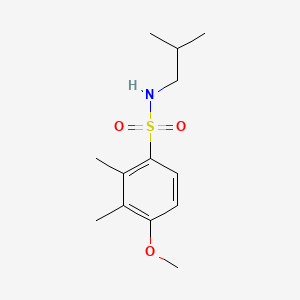
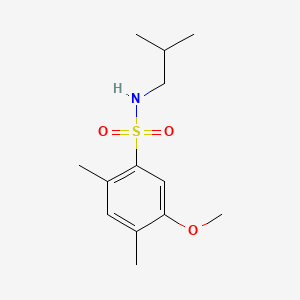
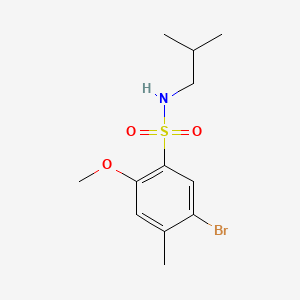
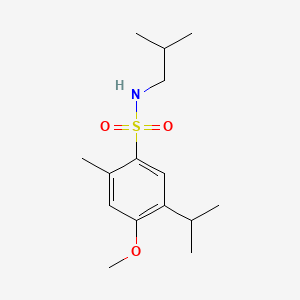
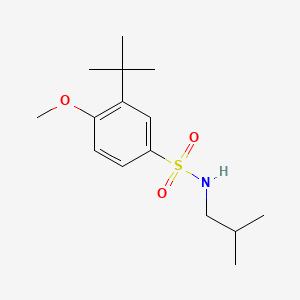
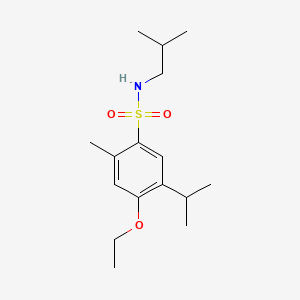
![(3-Hydroxypropyl)[(4-propoxynaphthyl)sulfonyl]amine](/img/structure/B604851.png)

![1-[(5-Isopropyl-2-methoxy-4-methylphenyl)sulfonyl]-4-(4-methoxyphenyl)piperazine](/img/structure/B604854.png)
![1-[(5-bromo-2-methoxy-4-methylphenyl)sulfonyl]-4-(4-methoxyphenyl)piperazine](/img/structure/B604855.png)
